The following was written by Hilary N. Karasz for Public Health Insider:
Public health focuses HIV prevention activities to those at highest risk. In King County, that has meant decades of intensive work to reduce transmission of HIV among men who have sex with men (MSM), the group most impacted by HIV locally. As a result of that targeted strategy, the number of new cases of HIV has been declining since the late 1990’s. Earlier this year, King County became among the first in the country to reach a very important global milestone in HIV prevention.
But new research led by one of our own Public Health epidemiologists has exposed the potential for HIV to expand among people other than MSM, specifically, to non-MSM who inject drugs such as methamphetamine. What’s behind this emerging risk and what does this mean for our prevention efforts? I spoke with Dr. Sara Glick, PhD, the lead investigator of this new study, to unpack the connection between meth use and HIV and understand how the study findings could inform future HIV prevention work.
First, to help understand your study, it focused on learning more about meth use locally. Why is that important for HIV prevention?
We know that meth is a strong and highly addictive stimulant that affects the central nervous system and has been linked to risky sexual behavior. Our estimate is that about 11 percent of MSM in King County are HIV-positive but for MSM who inject methamphetamine, we estimate that the percentage jumps up to 40-45 percent. To address this, programs like our needle exchange have been working with MSM to provide access to both substance use and HIV treatment, as well as clean needles to reduce HIV transmission. Knowing who is at risk helps target prevention work.
So your study looked at local meth use?
Yes. A recent report by the Alcohol and Drug Institute at the University of Washington documented signs that meth use has been increasing in our area– such as increased police cases, overdoses, and wastewater analysis. But we didn’t know who was using the meth. So, we wanted to find out just how much meth use had been increasing and in what populations. We analyzed survey data from 2009 to 2017 to look at meth use trends. What we found suggests that there is the potential for HIV to spread beyond the MSM population to other men and women who use methamphetamine.
What did you find that suggested there is potential for HIV to expand into populations of other men and women who are not MSM?
First, it’s important to note that our health department has not yet seen this uptick in HIV cases. However, our study shows that the potential is there. The bottom line is that evidence suggests that non-MSM who inject meth and share injection equipment may be at increased risk of HIV. Here’s why:
- We found clear evidence that people who inject drugs are doing more meth, especially non-MSM men and women. Meth use was reported by about 20 percent of non-MSM who inject drugs in 2009, and this increased to 65 percent in 2017.
- Our study also found about half of people who inject meth reported sharing drug injection equipment like syringes with other people, increasing risk of HIV transmission.
- There was evidence that some MSM and other men and women were sharing equipment with each other.
With this new information, what does the community need to know?
Many of the messages are ones we’ve been providing for many years. We recommend that people who inject drugs use clean injection equipment every single time they inject. If people are interested in reducing or stopping their meth use, they should talk with a social worker or health care provider about what treatment options would be best for them. People who inject any drugs and people who use meth should get regular HIV testing, especially if they share injection equipment. Heroin remains the most commonly reported injected drug, but many people are using both heroin and meth. In fact, many people report injecting these two drugs together, known as a “goofball.”
Also, know that if someone is HIV positive, there are extremely effective medications that can improve their health and eliminate the risk of transmission to others. In King County, we have very high rates of treatment among people who inject drugs who are HIV-positive.
What else can we do to limit the spread of HIV among injection drug users?
Our findings highlight the continued need for syringe exchange programs. These programs are places where people who inject drugs can get new, sterile equipment without judgment or stigma. Syringe exchange programs are also places where people can get connected to other related services like drug treatment, health insurance enrollment, wound care, and testing for HIV and hepatitis C.
If you use meth or know someone who does, what are some resources that could help?
Our Needle Exchange Social Work line (206-477-8241) is staffed by people who can help people who use injection drugs explore options for reducing use, treatment and reducing risk. There are also useful online resources as well – check out Crystal Meth Anonymous and Washington Recovery Help Line.


